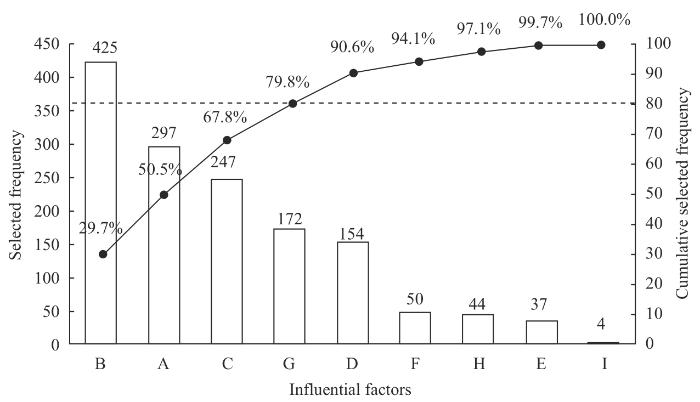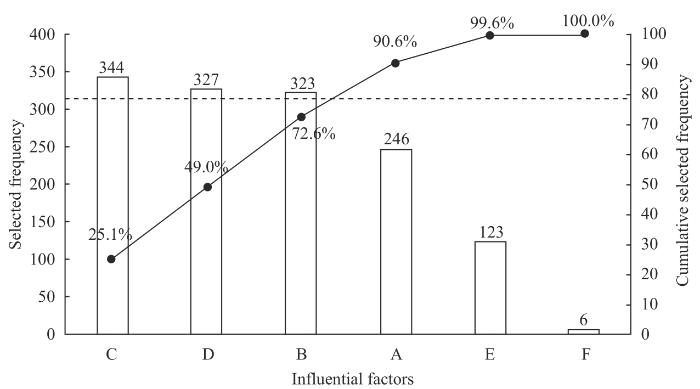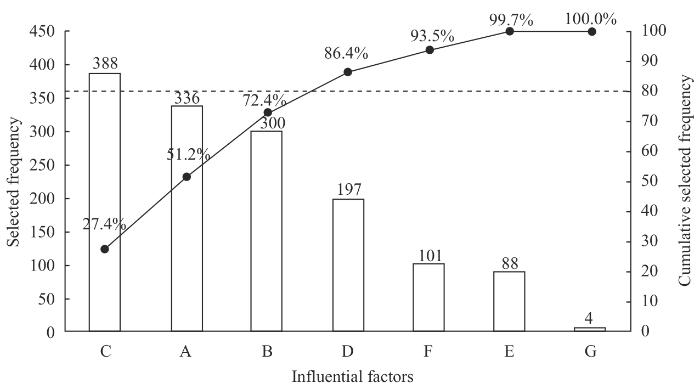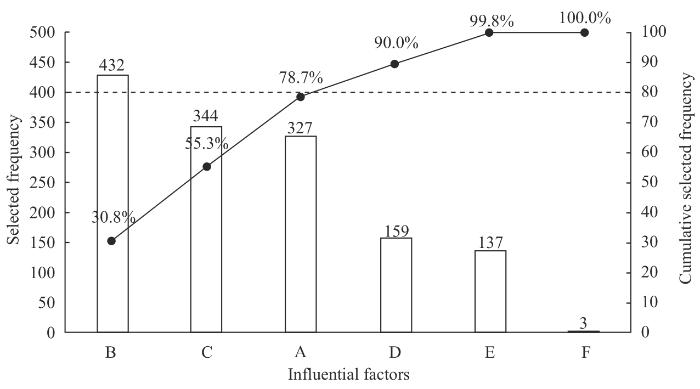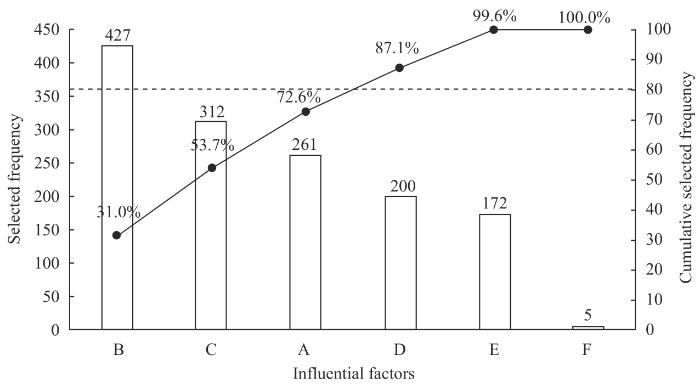临床研究不仅是临床诊治方法及医学学科发展的重要保证,验证科学假设、提供循证医学证据、推动医学进步的必由之路,也是人民健康生活的重要保障[1]。伴随着临床研究理念和方法的日新月异,复合型医务人员以及方法学专业人才显得尤为重要。经过几十年的发展,西方发达国家在临床研究方面已形成了相对完善的人才培养体系,以及由临床医师、护士、专职科研人员、项目管理、协调人员和临床研究方法学专业人员等组成的分类发展体系[2],给医学水平、医药产业的发展带来了快速提升。与发达国家相比,我国的临床研究起步较晚且尚处于较低水平[3-4],创新程度较高的Ⅰ期临床试验数量及国际多中心临床试验数量较少[5],多数研究设计缺乏严谨性和科学性,统计分析方法错误率较高,被引入高质量国内外临床实践指南的研究结果较少[6-7]。在临床医学证据方面我国仍处在“进口国”位置,超90%的临床诊疗技术源于西方发达国家的相关研究,多数常见疾病的诊断、治疗和预防等均基于西方国家人群的研究证据[8]。
目前,在我国临床研究越来越受到重视。2013年,由科技部、国家卫生计生委、总后卫生部正式启动了13个国家临床医学研究中心建设,带领全国各地的医院加强临床研究能力。此后相关文件陆续发布以鼓励医疗机构、医学研究机构、医药高等学校等开展临床试验。截至2022年,我国国家临床医学研究中心已达50家,各类临床研究机构陆续兴起,这使得高水平、专业化的人才队伍建设成为了亟待解决的问题,需要深入调研与思考。故而本研究通过问卷调研,分析我国临床研究人才队伍建设的现状与存在的问题,并提出有针对性的改进策略。
1 对象与方法
1.1 调查对象及其资料收集
本研究以来自全国27个省、市、自治区的医院、生物医药企业、医学院校、政府部门中熟悉临床研究的相关人员(共计583人)为调查对象。收集上述对象的相关资料,包括性别、学历、职称、工作单位、职业等。
1.2 研究方法
本研究采用问卷调查法,对我国临床研究人才建设情况进行分析。
1.2.1 问卷制作及其内容
本研究通过文献查阅、专家访谈和2轮德尔菲法进行问卷制作。首先,基于中国知网、万方、维普等文献数据库,系统检索2010年9月—2021年9月间与“临床研究人才发展现状与改进路径”主题相关的文献。通过文献归纳分析,初步形成针对该主题的调研问题清单。其次,邀请21位政府相关部门、高校科研管理部门、医院临床研究、生物医药企业的相关专家进行半结构化访谈,对调研问题进行补充和修改。再次,开展2轮德尔菲论证对调研问题及选项进行完善。在该论证中专家权威系数为0.837,问题总体变异系数为6.8%,肯德尔系数(Kendall)为0.474(P<0.001),总体意见一致性较强。最后,根据专家意见优化问题及选项,形成调查问卷。
调查问卷主要包括:当前制约我国高水平临床研究的主要因素界定、我国临床研究人才队伍建设的现状、问题以及改进策略,共8个问题,详见表1。
表1 调查问卷的问题清单
Tab 1
| Number | Main question |
|---|---|
| 1 | What do you think are the main factors restricting high-level clinical research in China? |
| 2 | Are you satisfied with the current situation of clinical research talent training in China? |
| 3 | What types of talents are the most lacking in the clinical research team at present? |
| 4 | What are the factors restricting the development of clinical research talents in China? |
| 5 | What are the clinical research capabilities that need to be improved for medical personnel? |
| 6 | What specialized courses are most needed to improve the clinical research ability of medical personnel? |
| 7 | To improve the clinical research ability of medical personnel, which training methods are more helpful? |
| 8 | What are the most necessary measures to fill the gap of clinical research methodology talents, clinical research project management specialists, clinical research coordinators and other professionals? |
1.2.2 问卷发放
待问卷制作完毕后,本研究通过“问卷星”的形式向调查对象进行网络问卷调研。
1.3 统计学方法
所有回收的调查问卷经审校后,使用SPSS 22.0软件进行统计学分析。定性资料以例数和百分率表示,采用χ2检验进行组间比较。调查问卷中的某问题选项被选中的结果采用帕累托图(亦称主次因素排列图)进行分析和展示,累积频率超过80%的前N个选项为该问题的主因。P<0.05表示差异具有统计学意义。
2 结果
2.1 问卷有效率及调查对象的基本情况
本研究共发放调查问卷583份,回收问卷583份;其中有效问卷579份,有效率为99.3%。在有效问卷对应的人群中,男性333人、女性246人,研究生学历276人(占比47.7%),高级职称136人(23.5%),主要来自上海(224人)、河南(63人)、北京(49人)等地(分别占比38.7%、10.9%、8.5%)。具体情况见表2。
表2 调查对象的基本情况[n (%)]
Tab 2
| Item | Respondent (n=579) |
|---|---|
| Gender | |
| Male | 333 (57.5) |
| Female | 246 (42.5) |
| Education ground | |
| Doctor degree | 114 (19.7) |
| Master degree | 162 (28.0) |
| Bachelor degree | 227 (39.2) |
| Undergraduate | 76 (13.1) |
| Professional title | |
| Senior | 60 (10.4) |
| Deputy senior | 76 (13.1) |
| Medium | 165 (28.5) |
| Primary | 220 (38.0) |
| Under primary | 58 (10.0) |
| Work place | |
| Hospital | 246 (42.5) |
| Grade-A tertiary | 187 (32.3) |
| Non grade-A tertiary | 59 (10.2) |
| Enterprise | 134 (23.1) |
| College and university | 111 (19.2) |
| Government | 47 (8.1) |
| Others | 41 (7.1) |
| Occupation | |
| Physician | 183 (31.6) |
| Nurse | 60 (10.4) |
| Teacher | 86 (14.9) |
| Researcher | 30 (5.2) |
| Administrator | 37 (6.4) |
| Corporation personnel | 137 (23.7) |
| Others | 46 (7.9) |
2.2 我国临床研究人才发展的现存问题与改进策略
2.2.1 影响我国高水平临床研究的主要因素分析
首先,本研究对影响我国高水平临床研究的相关因素进行调查,结果(图1)发现制约高水平临床研究的主要因素包括“临床研究一般周期过长,临床研究者迫于职称、评奖等要求,尽可能选择短、平、快的研究课题”(29.7%)、“目前科研评价体系导致‘轻临床、重基础’研究立项状况”(20.8%)、“临床研究牵涉面广,缺乏鼓励协作成果共享的举措以及建设协作共享的科研文化”(17.3%)、“医务人员日常诊疗工作忙,很难兼顾研究周期长的临床研究项目,如研究者发起的项目”(12.0%)、“高水平研究型人才的缺乏,同时缺乏一支专业支撑队伍”(10.8%)等。而这些因素均与临床研究人才队伍建设的现况和发展环境密切相关,因此我们聚焦临床研究人才发展的现存问题进行后续分析。
图1
图1
制约我国高水平临床研究的影响因素的帕累托图
Note: A. At present, the scientific research evaluation system has led to the establishment of research projects that focus on “less clinical than basic”. B. Generally, the clinical research cycle is too long, and clinical researchers are forced to choose short, easy and fast research topics as far as possible due to the requirements of professional titles, awards, etc. C. Clinical research involves a wide range of areas, lacking initiatives to share collaborative achievements, and build a collaborative research culture. D. Lack of high-level research talents and a professional support team. E. The number of clinical research wards is limited. F. Insufficient investment in clinical research and poor funding channel. G. Medical personnel are busy with their daily diagnosis and treatment, while some types of clinical researches, such as those initiated by researchers, take too much time and they cannot take care of both. H. Lack of channels to understand research frontiers and obtain other internal and external research experience, and limited research ideas. I. Others.
Fig 1
Pareto diagram of influential factors restricting high-level clinical research in China
2.2.2 临床研究人才培养现状的满意度评价
调研结果显示,在所有调研对象中对临床研究人才培养现状表示很满意的仅16人(占比2.8%),而表示很不满意、不满意和一般的共421人(72.7%);有关三甲医院、非三甲医院、非医疗机构这3类人员的满意度评价的具体数据见表3。
表3 调查对象对我国临床研究人才培养现状的满意度评价
Tab 3
| Satisfaction | Respondents (n=579)/n (%) | Hospital staff (n=246)/n (%) | Non-hospital staff (n=333)/n (%) | |
|---|---|---|---|---|
Grade-A tertiary hospital (n=187) | Non grade-A tertiary hospital (n=59) | |||
| Very dissatisfied | 77 (13.2) | 14 (7.5) | 4 (6.8) | 59 (17.7) |
| Dissatisfied | 137 (23.7) | 27 (14.4) | 17 (28.8) | 93 (27.9) |
| Average | 207 (35.8) | 69 (36.9) | 18 (30.5) | 120 (36.0) |
| Satisfactory | 142 (24.5) | 69 (36.9) | 19 (32.2) | 54 (16.2) |
| Very satisfied | 16 (2.8) | 8 (4.3) | 1 (1.7) | 7 (2.1) |
2.2.3 临床研究人才队伍建设现存问题的评价
从临床研究人才队伍的结构来看,调研结果(表4)显示,依据人才类型的缺乏程度排序,研究型医师的缺乏度第一,临床研究方法学人才(如统计师)位列第二。
表4 调查对象对临床研究人才类型的缺乏程度的评价统计
Tab 4
| Lack of talent type | No.1/n | No.2/n | No.3/n | No.4/n | No.5/n | No.6/n | Ranking average score/score | Final ranking |
|---|---|---|---|---|---|---|---|---|
| Research physician | 277 | 50 | 40 | 28 | 21 | 1 | 5.3 | 1 |
| Clinical research methodology talent (such as statistician) | 115 | 151 | 75 | 31 | 17 | 0 | 4.8 | 2 |
| Full time scientific researcher | 99 | 93 | 53 | 41 | 70 | 1 | 4.3 | 3 |
| Research nurse | 1 | 2 | 3 | 4 | 5 | 0 | 3.3 | 4 |
| Project management coordinator | 1 | 2 | 3 | 4 | 5 | 6 | 2.7 | 5 |
| Others | 1 | 2 | 0 | 4 | 5 | 6 | 2.4 | 6 |
从临床研究人才队伍建设的制约因素来看,调研结果显示“目前的绩效评价体系过于单一,薪酬、激励未向临床研究工作倾斜”(25.1%)、“在现有评聘体系中,无临床研究系列职称,从事临床研究的医务人员、临床研究支撑服务型人才缺乏晋升渠道”(23.9%)、“临床研究人才匮乏,现有人员的临床研究能力不足”(23.6%)、“管理者对临床研究重要性认识不足”(18.0%)是主要因素,具体数据见图2。
图2
图2
制约临床研究人才建设的影响因素的帕累托图
Note: A. Managers have insufficient understanding of the importance of clinical research. B. There is a shortage of clinical research talents, and the current personnel are lack of clinical research ability. C. The current performance evaluation system is monotonous, meanwhile the salary and incentive are not profit able for clinical research. D. In the existing evaluation and employment system, there is no clinical research professional title, and medical personnel engaged in clinical research and support staff lack promotion channels. E. The lack of research culture of collaboration and sharing makes it difficult to form a strong clinical research cooperation team. F. Others.
Fig 2
Pareto diagram of influential factors restricting the construction of clinical research talents
2.3 我国临床研究人才队伍建设的改进策略
本研究从提升在职临床研究人员的科研能力、扩充临床研究人才队伍这2个维度,对临床研究人才队伍建设行进一步的细化分析。首先,科研能力提升方面,“规范化实施临床研究,包括质量控制与数据采集”(27.4%)、“发现临床问题、凝练研究方向”(23.8%)、“临床研究设计”(21.2%)、“统计分析等临床研究方法”(14.0%)应是能力培训的重点,具体数据见图3。
图3
图3
临床研究人员亟需提升的核心能力的帕累托图
Note:A. Finding clinical problems and refining research direction. B. Clinical study design. C. Standardizing clinical research, including quality control and data collection. D. Statistical analysis and other clinical research methods. E. Knowing relevant laws and regulations. F. Communication, coordination, organization and management during project implementation. G. Others.
Fig 3
Pareto diagram of core competences that clinical researchers need to improve
其次,从理论课程体系建设的角度,应重点加强“临床研究方法学课程(包括研究设计、流行病学与统计学等方法学内容)”(30.8%)、“临床研究相关法规(如伦理规范、监管政策等)”(24.5%)、“临床本专业核心知识及新进展(包括理论与操作)”(23.4%)、“医学前沿理论与技术”(11.3%)等课程体系建设,具体数据见图4。
图4
图4
临床研究人员能力培训的课程体系建设的帕累托图
Note: A. Core knowledge and new progress of clinical specialty (including theory and operation). B. Clinical research methodology course (including research design, epidemiology and statistics). C. Laws and regulations related to clinical research (such as ethical norms, regulatory policies, etc.). D. Advanced medical theories and technologies. E. Interpretation of actual cases in clinical research. F. Others.
Fig 4
Pareto diagram of curriculum system construction for competence training of clinical researchers
再次,从临床研究人才的培养方式来看,“在医师和护士的学校培养阶段,增加设置临床研究相关课程”是首选方式(占比55.8%),“有临床研究经验的导师指导新人,团队传帮带”“开展短期在职培训,结合案例进行教学”分别位列第二、第三,具体数据见表5。
表5 临床研究人才培养方式的选择及统计
Tab 5
| Item | Respondents (n=579)/n (%) | Ranking |
|---|---|---|
| Adding clinical research-related courses in the school training stage of doctors and nurses | 323 (55.8) | 1 |
| Guiding new people and helping them in teams by tutors with clinical research experience | 287 (49.6) | 2 |
| Carrying out short-term on-the-job training and teaching with cases | 279 (48.2) | 3 |
| Participating in high-level and standardized clinical research projects | 208 (35.9) | 4 |
| Conducting expert forums to promote peer exchanges | 180 (31.1) | 5 |
| Joint training with enterprises with clinical research experience, and short-term exchange of talents | 148 (25.6) | 6 |
| Others | 2 (0.3) | 7 |
在队伍扩充方面,调研结果(图5)显示临床研究人才队伍的扩大主要可从如下4个方面着手,即“在医学统计、预防医学、临床护理、医学检验等相关专业培养中,增加临床研究课程”(31.0%)、“加大临床研究方法学专业招生,培养临床研究专业人才”(22.7%)、“向社会招聘具有相关资质的临床研究从业人员,开展短期培训”(18.9%)、“设置临床
图5
图5
临床研究人才队伍扩充关键途径的帕累托图
Note: A. Recruiting clinical research practitioners with relevant qualifications from the society, and carrying short-term training. B. Increasing clinical research courses in the training of medical statistics, preventive medicine, clinical nursing, medical laboratory and other related majors. C. Increasing the enrollment of clinical research methodology, and cultivating clinical research professionals. D. Setting clinical research degree points to attract and cultivate graduate level clinical research methodology talents. E. Setting special clinical research posts, improving the professional title evaluation and employment scheme, and improving the career stability of clinical researchers. F. Others.
Fig 5
Pareto diagram of key approaches to expand clinical research talents
研究学位点,吸引并培养研究生层次的临床研究方法学人才”(14.5%)。
3 讨论
从调研结果可以看出,高层次研究型医师和临床研究方法学专业人才缺乏,以及临床研究人才队伍的发展环境不佳,是制约我国临床研究发展的瓶颈问题。基于此,本研究提出如下思考。
其次,做好医师临床研究能力提升的在职培训。加大在职培养力度,对临床研究型医师进行系统性的科研能力提升,在临床研究项目规范实施、选题设计等方面开展短期在职培训并结合案例进行教学,开展科研论坛、讲座等,帮助医师掌握最新的临床专业知识及研究进展;鼓励青年医师参与高水平、规范的临床研究项目,在实践中锻炼成长,并发挥高水平研究型医师的传帮带作用,为我国临床研究的发展培养人才[11]。
第三,加大临床研究方法学的专业人才培养力度。在我国,临床研究服务机构的整体从业人员的专业化素质偏低,专业人才缺乏成为了行业发展的一大瓶颈[12-13]。医学院校、医院和科研机构的薪酬待遇在市场上的竞争力较弱,使得临床研究方法学专业人才在上述机构更为稀缺。目前,部分医学院校已开设相关专业课程以进行职业教育;而在高层次的学历教育方面,国内仅北京大学设立了“临床研究(方法)学”二级学科硕士及博士学位点(从2015年起招收研究生)。因此,在我国建立临床研究方法学专业人才培养体系不仅是医学教育界面临的较大挑战,也是该领域学者们的使命和责任[14]。医学院校一方面应顺应需求,增加临床研究方法学人才的培养数量,另一方面需加快产出优秀方法学研究成果、编制专业教材,在临床研究方法学的创新、应用中进行探索,以建设临床研究方法学学科,培育高水平的临床研究方法学专业人才。
第四,重视临床研究,进一步优化临床研究人才队伍发展环境。在医学科研领域仍然存在重基础研究、轻临床研究的现象,同时临床医师忙于应对繁重的医疗事务、职称评聘量化要求,参与临床研究的积极性不够。当前,临床研究方法学专业人才在国内的待遇并不高,使得该类人才外流、转行的现象比较严重。这就要求政府、高校、医院的相关管理部门进一步重视临床研究,优化临床研究人才队伍的发展环境,提高临床研究人才待遇,完善临床研究人才职称晋升、绩效评估及资源分配体系,倡导鼓励协同合作、成果共享的科研文化,引导、激励各类临床研究人才释放创新活力、发挥合力,从而促进临床研究水平的快速提升。
目前,高层次临床研究人才的匮乏已严重影响了我国医学领域的发展。在借鉴发达国家的经验的同时,我们还应当扩大招生规模,完善学校教育和在职培训体系,加大研究型医师、临床研究方法学专业人才等的培养力度,扩充我国临床研究的人才队伍,从而从根本上推动临床研究的发展,促进我国真正地成为世界医学科研领域的前沿阵地。
作者贡献声明
李冬凉、王炳顺参与了研究设计;李冬凉、王炳顺、王甦平、何豪参与了问卷设计和数据收集;李冬凉、周良、王甦平参与了数据分析、论文的写作和修改。所有作者均阅读并同意了最终稿件的提交。
AUTHOR's CONTRIBUTIONS
LI Dongliang and WANG Bingshun participated in the research and design. LI Dongliang, WANG Bingshun, WANG Suping and HE Hao participated in the questionnaire design and data collection. LI Dongliang, ZHOU Liang and WANG Suping participated in data analysis, paper writing and revision. All the authors have read the last version of paper and consented for submission.
利益冲突声明
所有作者声明不存在利益冲突。
COMPETING INTERESTS
All authors disclose no relevant conflict of interests.
参考文献



